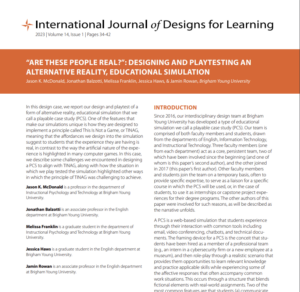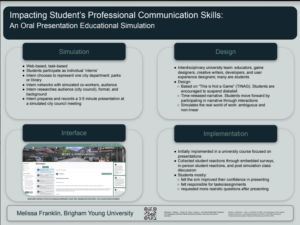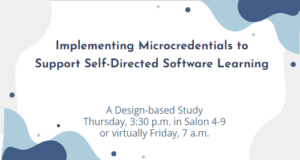Research, Publications and Presentations

Abstract: In this design case, we report our design and playtest of a form of alternative reality, educational simulation that we call a playable case study (PCS). One of the features that make our simulations unique is how they are designed to implement a principle called This Is Not a Game, or TINAG, meaning that the affordances we design into the simulation suggest to students that the experience they are having is real, in contrast to the way the artificial nature of the experience is highlighted in many computer games. In this case, we describe some challenges we encountered in designing a PCS to align with TINAG, along with how the situation in which we play tested the simulation highlighted other ways
in which the principle of TINAG was challenging to achieve.
McDonald, J., Balzotti, J., Franklin, M., Haws, J., & Rowan, J. (2023). “Are These People Real?”: Designing and Playtesting an Alternative Reality, Educational Simulation. International Journal of Designs for Learning, 14(1), 34–42. https://doi.org/10.14434/ijdl.v14i1.34682

Abstract: Playable Case Studies (PCSs) are online simulations that allow learners to adopt (play) a professional role within an authentic scenario (case) as they solve realistic problems alongside fictionalized experts in an unfolding narrative. I will present the design, development, and initial implementation of a new oral presentation skills PCS entitled Seneca, and will demonstrate the impact of a situated learning experience on student learning.
Franklin, M. (2022, October 24 – 28). Impacting Student’s Professional Communication Skills: An Oral Presentation Educational Simulation [Conference poster presentation]. AECT 2022 Convention, Las Vegas, NV, United States.

Abstract: In this article, we describe a preliminary study that explores the authenticity of a new brand of educational simulation. Below, we discuss how the authentic recreation of a presentation situation was experienced by students in an advanced professional communication class. During the simulation, students took the role of virtual city planners in a fictional mid-west town where they were asked to complete various tasks and interactions with different city planners and city board members. We used classroom observations along with pre- and post-test surveys to explore students’ acquisition of oral presentation skills and their use of isolated presentation competencies (Smith, 2010). Students and instructor responses to presenting in a simulated environment were positive. The opportunity to practice presenting to fictional stakeholders also included a disadvantage of pre-recorded questions for presenters to answer.
J. Balzotti, J. McDonald, L. Rice and M. Franklin, “Presenting in Virtual Spaces: Students’ Experience in a Simulated Playable Case Study,” 2022 IEEE International Professional Communication Conference (ProComm), Limerick, Ireland, 2022, pp. 328-332, doi: 10.1109/ProComm53155.2022.00067.

Summary: Research within the field of higher education has rapidly expanded over the past 50 years. The purpose of this study was to synthesize the research of higher education from 1970 through 2020 and identify the trends and themes in that time period. While many authors have surveyed higher education research by studying all publications (output), we reviewed the field by focusing on the publications that made the biggest impact through the number of citations (outcome). We used a bibliometric literature analysis to identify the 20 most highly cited journal articles of each decade and then measured the number of citations. This comparison of citation counts allowed us to trace the growth and changes in topics of the most interest to higher education researchers and determine which themes had the most impact on the field. Themes centering on students and learning—such as effective teaching, retention, engagement, assessment, feedback, and employability—were the most common among the high-impact articles. Our findings suggest that over time, the field of higher education has moved away from a teacher-centered approach and more towards a student-centered focus in order to encourage deep, applied learning. The results of our analysis also showed that many of the identified trends are connected to the social, political, and economic influences of the same time periods, including an increasingly diverse and growing student population and a transformation in education delivery methods.
Franklin, M., Chan, J., Gardner, K., Measom, E., Sandberg, B., Irvine, J., & Kimmons, R. (2021). Higher Education: A History of Research Trends from 1970 to 2020. In R. Kimmons & J. Irvine (Eds.), 50 Years of Education Research Trends. EdTech Books. https://edtechbooks.org/50_years/higher_education

Implementing Microcredentials to Support Self-Directed Software Learning
Abstract: This roundtable will present a design-based study about developing microcredentials to support self-directed learning in semi-formal educational settings. The study began by implementing competency-based microcredentials to train student instructors. It is now on the second iteration expanding the program to offer microcredentials to all students on campus through project-based assessments. After sharing our design-based iterative process and evaluative data, we will facilitate a discussion around promoting and scaling microcredentials in similar settings
Zhang, J., West, R., Franklin, M. (2021, ). Implementing Microcredentials to Support Self-Directed Software Learning [Conference presentation]. AECT 2021 Convention, Chicago, IL, United States.
Agency and Assessment: An Annotated Bibliography (2021)
Agency and assessment brings in fields of philosophy and psychology, and researchers in the areas of Self-Regulated Learning, Self-Determinism, feedback, experiential learning, teacher education, Assessment for Learning and others. This annotated bibliography focused on the most recent research and best practices for instructors enabling greater student agency in assessments.